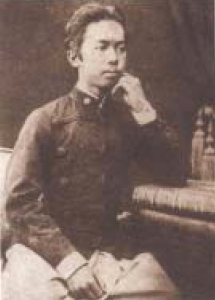
Prince Damrong Rajanubhab graduated from Chulachomklao Royal Military Academy when he was 15 years old (1877), received the rank of First Lieutenant in the Royal Guard Brass Band Regiment. In the picture was the uniform of Second Lieutenant
This story is quite long and will be divided into 2 parts. The first part mentioned to the causes of provincial administration in form of Thesapibal. The latter one discussed about the process of Thesapibal administration that I had greatly involved.
The secretive reasons why I became a minister of Ministry of Interior should be told in archaeology as the time had already passed for 50 years.
In the past, Minister of Interior was called Akkara Maha Senabodi (chief of minister). Samuha Nayok was the head of civilian affairs, looked after all northern provinces, equalled to Minister of Defence (Samuha Kalahom), who governed southern provinces. Those who had become the Ministers of Interior had worked as civil services for a long time before they got promoted to be Senabodi Jatusadom (the four columns; Wiang, Wang, Klang, or Na), for instance, Phraya Rattana Bordin who was the minister of interior before me. Prior to that, he was permanent secretary of interior in the name of Phraya Ratwaranukul. He then served as Phraya Pollathep, minister of agriculture between Rama IV and Rama V and became Samuha Nayok, minister of interior afterwards. However, after I left the school, I served as a military officer in the Department of Chamberlain. I had been a military cadet and gradually promoted to royal guard. I had never been a colonel because in those days, the colonel of the Royal Chamberlain must be the king only.
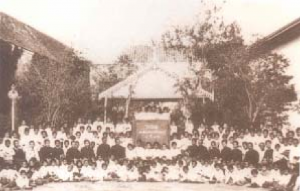
“Phra Tumnuk Suankularb School” where Prince Damrong Rajanubhab started his first education management job by changing from “Chamberlain Military Academy” which was a military training school for civilian schools
I started to serve the government when I was the commandant of chamberlain and asked for the formal royal palace at Suankularb to set up a training school for noble children who were cadet chamberlains. “Phra Tumnuk Suankularb School” was established in1882. Once the school was thrived, the candidates applied for school were excess the limit of cadets. The school had to limit the number of students for those who didn’t want to be solders as well. Hence, I requested the king to provide school for noblemen with a general purpose, not only to be a cadet. The king said that those graduates who didn’t aim to be soldiers would probably get another government service. The scope of instruction in Phra Tumnuk Suankularb School was expanded to cover basic subjects in primary level (Prathom), the so-called “Prayok 1” (sentence 1) and “Prayok 2” (sentence 2) for secondary level (Matthayom). To be precise, students who completed Prayok 2 later became Krom, Chao Phraya Senabodi and many more top positions in the next reign.
His Majesty once visited the school to bestow the prizes for students. Shortly afterwards, His Highness told me that education would be the key factor in the future. It was great that I successfully set up Phra Tumnuk Suankularb School. Thus, I was assigned to set up more public schools since I was the commandant of chamberlain.
Army and navy had been combined under “Krom Yutthanathikarn” (Ministry of War and Marine) in 1877. I was promoted to the rank of Major General and the assistant military chief in the Ministry of War and Marine. I had to leave the department of chamberlain. My task related to school setting then separated to another independent department called “Department of Education”, the office was a building in the east of Phiman Chai Si Gate and appointed me for the director-general of the Department of Education. At that time, I had held both military and civilian positions for 2 years. In 1889, department of religious affairs, Buddhism, nursing and museum which had been independent, we subjected to Department of Education and upgraded to “Ministry of Education”. I had absolutely been vacated from Assistant Commander-in-Chief of the Royal Thai Army to work as the Director-General of Ministry of Religious Affairs in the early 1890; I therefore only served for civil service since then.
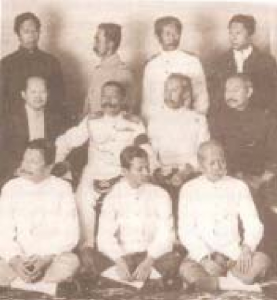
Senabodi of each ministry taken by His majesty Chulalongkorn
Left to Right
Front Row
- Chao Phraya Thewetwongwiwat (M.R. Larn Kunchorn)
- Krom Muen Ratburi Direkrit (Prince Raphi Phatthanasak Krom Luang Ratburi Direkrit )
- Chao Phraya Wichit Wongwutthikrai (M.R. Klee Suthat)
Middle Row
- Krom Luang Devawongse Varoprakar
- Somdej Chaofa Krom Phra Bhanubandhu Vongsevoradej
- Krom Luang Naresr Vorarit
- Krom Khun Sommot Amonphan
Back Row
- Chaofa Krom Khun Narisara Nuwattiwong
- Krom Luang Damrong Rajanubhab
- Krom Khun Pittayalarb Pruttitada (Sonabandit)
- Krom Muen Mahisara Rajaharudaya (Jayanta Mongkol)
I had absolutely separated from military and only worked as the Director-General of Religious Affairs because of politics. Due to the previous regime, there were only 6 ministers, which were 2 senabodi and 4 from Jatusadom became outdated. Thailand needed to modify and transform the administration over the country. His Majesty firstly would like to offer sufficient ministers. In 1887, Krom Luang Devawongse Varoprakar was assigned to help in organising the Golden Jubilee of Queen Victoria in England and observed the system of European ministers at once. After his Europe trip, 12 ministries were set up, six existing ministries together with six new ministries, namely, Finance, War and Marine, Justice, Religious Affairs, Public Works, and Murathathorn (maintaining royal seal and great seal of the realm). All this, 12 ministers of each ministry owned identical authority while 2 positions of Akkara Maha Senabodi had been removed. His Majesty also worried that to appoint these 12 positions immediately would cause problems as there were a lot of independent departments and ministers themselves were green to their duties. His Majesty tried the new regulations and trained the new ministers. In 1888, the meeting was attended by all former and new ministers in Mukkasan, Dusit Maha Prasat Throne Hall. His Majesty presided over the meeting. The meeting was held at least once a week. Sometimes, it could be several nights in a row if there were many issues. I was chosen to be the first Minister of Religious Affairs and attended in the ministerial conference since I was Director General of Department of Education. Therefore, the aim of combining various departments to set up as the Ministry of Religious Affairs and separating me from the military was to raise the department as the ministry.
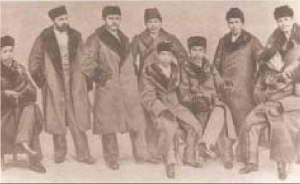
His Majesty Chulalongkorn entrusted Krom Muen Damrong Rajanupab as a royal representative to visit King Tsar Nicholas II when he was Tsarevich Nicholas of Russia. This photo was taken with special delegates in Russia
His Majesty had tried the new regulation for 3 years. In July, 1891, Tsarevich of Russia, heir apparent (King Nicholas II) came to Thailand. I was entrusted to visit Tsarevich as already mentioned in the 5th story of strange things in Jaipur. I went to Europe at that time and was given permission to go to Egypt and India on the way back in order to explore more knowledge together with what I had seen in Europe to apply for the benefit of the Ministry of Religious Affairs. A week after I arrived Bangkok at the end of March, the Royal Command announced the designation of twelve ministers. Some of ministers were replaced at the end of the Royal Command. In case of Phraya Rattana Bordin, Minister of Interior who was very old, was vacated and received the pension. I was then the Minister of Interior since the 1st of April, 1892.
In fact, His Majesty transferred me from Ministry of Religious Affairs to be the Minister of Interior without any notifying in advance. I had to move immediately with Chao Phraya Sadej (M.R. Pia Malakul), or Luang Paisarn Silapasart at that time who was my secretary. Later in April, I got a chance to confide with the king that I had set up and practiced of the Ministry of Religious Affairs. If I had continued working there, I would have created much progress. In contrast to Ministry of Interior, I rarely had idea about it and afraid that I would make mistake and disappointed him. His Highness replied that he believed that I was able to manage religious affairs well but the duty of Ministry of Interior was much more crucial to the nation than we could expect. Foreigners were looking forward to invading us; perhaps we would lose our freedom. It was usual to feel unconfident when we first started a new job. If I had any issues, I could ask for advice from His Majesty. Exactly, I felt much relieved after the conversation. I asked for one thing, to send me back to Ministry of Religious Affairs when he considered that I failed this new mission.
How Ministry of Interior was when I was the minister is also interesting. I would write about Sala Luk Kun or Luk Kun Hall (Hall of Jury) in the Grand Palace which was the office of Ministry of Interior, followed by the officers in Luk Kun Hall and the former working process in the Ministry of Interior respectively.
“Luk Kun Hall” consisted of 3 buildings in Ayutthaya style. One building was outside the palace (next to the pillar hall), a place for judicial chamber, called “Jury at royal court” to work as Court of Justice. Other two buildings were in the grand palace. This was the source of the names “Sala Luk Kun Nok” (outside) and “Sala Luk Kun Nai” (inside). Sala Luk Kun Nai was a place for senior civil servants in administrative departments, called “Jury at Hall”, one on the left for the civil service meeting which was under the Minister of Interior who performed as Samuha Nayok, head of civil service. The other one on the right side was for the meeting of military officials under the Minister of Defence, who was Samuha Kalahom, head of the military officials as well.
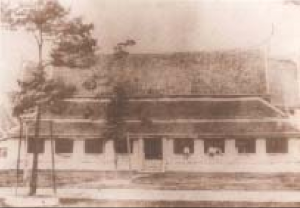
Sala Luk Kun Nai in the reign of King Rama III
It was one floor twin building, one used for the office of Ministry of Interior and another one for Ministry of Defence until the bureaucratic reform during King Rama V period
Luk Kun Hall was a large single-storied hall. It was first wooden building in the reign of King Rama I before renovated to a cement building in the reign of King Rama III. Front part of the hall was used for civil servant meeting and a place for guests to stay while waiting for having an audience with royalty. There was a wooden partition in the middle of the hall to divide into 2 rooms. The south side was a room for the office of the Ministry of Interior and another one for Ministry of Defence. Actually, the duties of these two ministries included of 3 divisions; the first division was Akkara Senabodi who had to assign missions to various departments. This devision required an office and full-time officers day and night; the second division was to administrate provinces. This kind of work didn’t have to be done at Luk Kun Hall but this division highly required literate specialists to determine official report from the province. The Ministry of Interior and Defence had a duty officer and a clerk who was skillful in writing call-up orders at Luk Kun Hall. These people also worked for this division; the third division was judiciary. The Ministry of Interior and Defence are the Court of Appeals for the provinces under their command, having juries and the prison for that department separately. The court was set up at the house of senabodi and had to find a location for the prison. When I became the Minister of Interior, the ministry’s prison was located by the wall in front of the palace, right behind the Ratsadakorn-bhibhathana Hall. Other ministries also had the duty of the judiciary to judge a case. Both the court and the office of the ministry were set up at the home of the minister. Therefore, in the past, the ministers worked at home even having offices elsewhere. For example, the Ministry of Interior and Ministry of Defence didn’t work at the offices. Officials in the ministry always had to be assigned at the minister’s resident. But according to tradition, government officials in each ministry except the minister received only annual pension and various fees, not a salary.
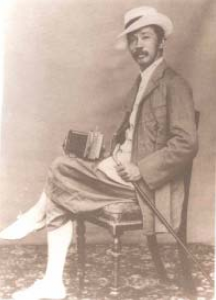
Krom Phraya Damrong Rajanubhab with his favourite camera
Krom Phra Klang that related to foreign affairs (Krom Tha) was included in the same ministry that led by Chao Phraya Phra Klang Senabodi Jatusadom. In 1875, His Majesty Chulalongkorn separated Phra Klang and set up as a ministry located at Ratsadakorn-bhibhathana Hall. It was the first ministry that organised and operated in western way. To be exact, the officers worked in office hours every day and received payment in form of salary instead of the fee. The king thought that Prince Mahamala Krom Phra Bamrab Porapak served as the director-general of Minister of the Royal Household and Krom Phra Klang. Then he was allowed to keep working at the palace until 1885, Prince Devawongse Varoprakar (Krom Muen at that time) was Senabodi Krom Tha (Chief of Treasury Department) suggested that there should be a workplace so he asked permission from the king to use Saranrom palace as an office of the Ministry of Foreign Affairs. Prince Devawongse Varoprakar was the first senabodi who worked in office hours every day and received salary as same as other officials in the ministry. When the story was written, the king intended to re-organise the Ministry of Interior and the Ministry of Defence in the same way Ministry of Finance and Foreign Affairs had already been arranged. Consequently, the two Luk Kun Halls were pulled down in order to build three of two storied buildings, with a pulpit on both the front and back, connecting the 3 buildings as it can be seen. The building behind to the left at the Suwanbiban Gate was built on the former location of Luk Kun Hall of the Ministry of Interior. The building on the right was built on the former location of Luk Kun Hall of the Ministry of Defence, using the common entrance at the front of the central building which was rebuilt for the meeting. There was also a separate entrance at the back. Once the building was completed, the Ministry of Interior would attach to the left side of the porch while the Ministry of Defence was on the right side. Both ministries had no idea how to share the new central building, so the Ministry of Royal Household (Wang) requested it to be used as a storehouse to keep tables and chairs.
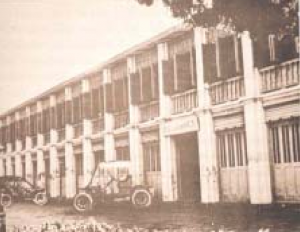
When the Ministry of Interior was first established on the 1st of April, 1892, the ministry was living at a 2-storied building in front of Phiman Chai Si Gate, opposite the Sahathai Thai Pavilion where used to be the Royal Guard Regiment for almost 2 years
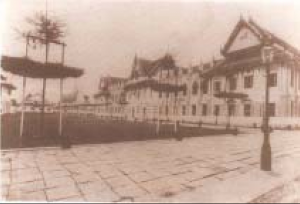
Later, His Majesty Chulalongkorn decided to reorganise the Ministry of Interior and Ministry of Defence, two of Sala Luk Kun Nai were then removed and built two-storied buildings instead. Somdej Krom Phraya Dam Rajanuphab had been serving for this ministry until his retirement.
After Ministry of Interior and Ministry of Defence had already located at Luk Kun Hall, civil servants with full time job positions in both ministries would receive salary as same as the Ministry of Finance and the Ministry of Foreign Affairs. Civil servants in the Ministry of Interior and Ministry of Defence had two different benefits. First group of people who worked in Luk Kun Hall received salary and second one who worked elsewhere as well as the two ministers received only the fees. I was the first minister that got paid by salary. No one in both ministries was able to modernise the regulations. They probably worked the same way as before at the old Luk Kun Hall. Until I had become the Minister of Interior, I therefore saw the old way of what they had done.
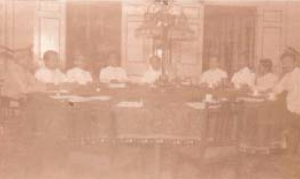
His Majesty Chulalongkorn presided over the ministerial conference at Vimanmek Mansion, Dusit Palace.
Full time officers in Luk Kun Hall referred to Permanent Secretary, or the senior civil servant who performed the duty Permanent Secretary, and commissioned officers (Phra or Luang). The next were the clerks. There were 4 duty officers, namely, “Mr. Kwaen Kochasan” one “Mr. Chamnan Pharn”, “Mr. Kuanroo Atsawara” and “Mr. Rad Truadpol”. All of them worked at Luk Kun Hall during the day and they had to take turn their shifts to stay overnight at the Luk Kun Hall at night. For the civil service that came in the evening for 15 days each time, called “on duty”, the position of chief is called “duty officer”. The job of duty officers were not only at night. If there was something occurred at Ministry of Interior during his turn, that duty officer must carry out until it finished, as described. There was another staff member working in Luk Kun Hall, called “the Department of Tribute” (I’m not sure.), but I remembered that it was a newly established department. Formerly, the Ministry of Interior and Defence had 4 positions of Hua Bhan. Hua Bhan of Ministry of Interior included of “Bhan Phut Anuraj”, “Bhan Chantumart”, “Bhan Bhanurat” and “Bhan Phao Assavarat”.
One of them was an officer in arranging people when a civil service occurs and an inspector of the Interior to ensure other departments followed Ministry of Royal Household notices. Bhan Anuraj was a recruiter or to hire someone to do business. The Ministry of Defence also had “Bhan Thepparaj” to do this job. Therefore, money passed through these two people. Prince Narathip Praphanphong asked to set up Department of Tribute (Revenue) in both the Ministry of Interior and Defence. Bhan Phut Anuraj was promoted to Phra Worrawut Pokai in the Ministry of Interior. Bhan Pettaraj was promoted to be Phra Uthai Thepthon in the Ministry of Defence. For accelerating the payment of tribute from the provinces and sending the treasury would receive salary in both departments.
There were two groups of officers in Luk Kun hall. The first group was those who were born in the families of senior officials in Ministry of Interior, served as the chamberlains and knew about civil services. Another group was the children of the rich. They applied to train in Ministry of Interior since they were teenagers, started their jobs from being clerks and being promoted to higher positions by their capacity. All duty officers were all up from clerks. They were therefore more skilled in the process of the ministry than the aristocrats who were noblemen. But only a few of these classes could be commissioned as noblemen. Nonetheless, some duty officers were senior civil servants in the Ministry of the Interior as well.
Such as Phraya Chasaen Yobbordee (Klib) and Phraya Ratchawaranukun (Uam) who were Phraya Cha Senabodi (Thai), once were clerks and duty officers. Using their existing people was an ancient method that various ministries used. The idea of recruiting new people had just started after the establishment of twelve ministries, as described in the 14th story, about the Royal Pages School (Mahadlek Luang School).
